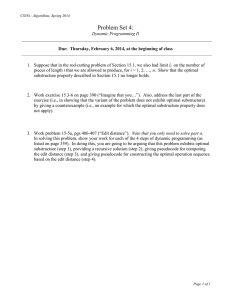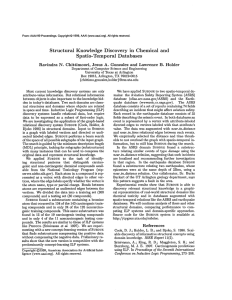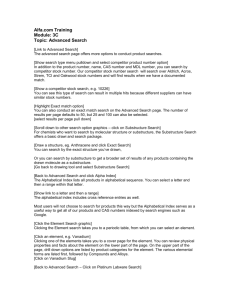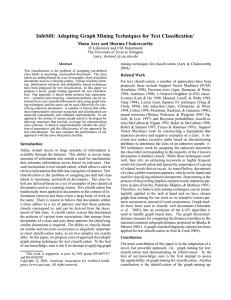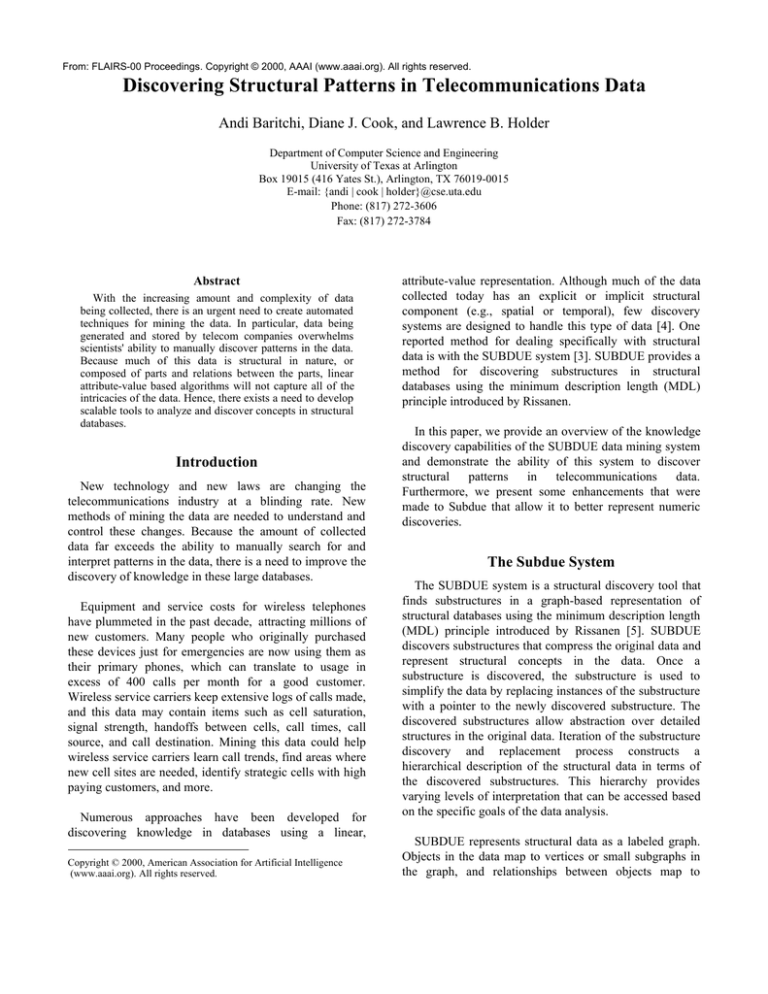
From: FLAIRS-00 Proceedings. Copyright © 2000, AAAI (www.aaai.org). All rights reserved.
Discovering Structural Patterns in Telecommunications Data
Andi Baritchi, Diane J. Cook, and Lawrence B. Holder
Department of Computer Science and Engineering
University of Texas at Arlington
Box 19015 (416 Yates St.), Arlington, TX 76019-0015
E-mail: {andi | cook | holder}@cse.uta.edu
Phone: (817) 272-3606
Fax: (817) 272-3784
Abstract
With the increasing amount and complexity of data
being collected, there is an urgent need to create automated
techniques for mining the data. In particular, data being
generated and stored by telecom companies overwhelms
scientists' ability to manually discover patterns in the data.
Because much of this data is structural in nature, or
composed of parts and relations between the parts, linear
attribute-value based algorithms will not capture all of the
intricacies of the data. Hence, there exists a need to develop
scalable tools to analyze and discover concepts in structural
databases.
Introduction
New technology and new laws are changing the
telecommunications industry at a blinding rate. New
methods of mining the data are needed to understand and
control these changes. Because the amount of collected
data far exceeds the ability to manually search for and
interpret patterns in the data, there is a need to improve the
discovery of knowledge in these large databases.
Equipment and service costs for wireless telephones
have plummeted in the past decade, attracting millions of
new customers. Many people who originally purchased
these devices just for emergencies are now using them as
their primary phones, which can translate to usage in
excess of 400 calls per month for a good customer.
Wireless service carriers keep extensive logs of calls made,
and this data may contain items such as cell saturation,
signal strength, handoffs between cells, call times, call
source, and call destination. Mining this data could help
wireless service carriers learn call trends, find areas where
new cell sites are needed, identify strategic cells with high
paying customers, and more.
Numerous approaches have been developed for
discovering knowledge in databases using a linear,
Copyright © 2000, American Association for Artificial Intelligence
(www.aaai.org). All rights reserved.
attribute-value representation. Although much of the data
collected today has an explicit or implicit structural
component (e.g., spatial or temporal), few discovery
systems are designed to handle this type of data [4]. One
reported method for dealing specifically with structural
data is with the SUBDUE system [3]. SUBDUE provides a
method for discovering substructures in structural
databases using the minimum description length (MDL)
principle introduced by Rissanen.
In this paper, we provide an overview of the knowledge
discovery capabilities of the SUBDUE data mining system
and demonstrate the ability of this system to discover
structural
patterns
in
telecommunications
data.
Furthermore, we present some enhancements that were
made to Subdue that allow it to better represent numeric
discoveries.
The Subdue System
The SUBDUE system is a structural discovery tool that
finds substructures in a graph-based representation of
structural databases using the minimum description length
(MDL) principle introduced by Rissanen [5]. SUBDUE
discovers substructures that compress the original data and
represent structural concepts in the data. Once a
substructure is discovered, the substructure is used to
simplify the data by replacing instances of the substructure
with a pointer to the newly discovered substructure. The
discovered substructures allow abstraction over detailed
structures in the original data. Iteration of the substructure
discovery and replacement process constructs a
hierarchical description of the structural data in terms of
the discovered substructures. This hierarchy provides
varying levels of interpretation that can be accessed based
on the specific goals of the data analysis.
SUBDUE represents structural data as a labeled graph.
Objects in the data map to vertices or small subgraphs in
the graph, and relationships between objects map to
directed or undirected edges in the graph. A substructure is
a connected subgraph within the graphical representation.
This graphical representation serves as input to the
substructure discovery system. Figure 1 shows a geometric
example of such an input graph. The objects in the figure
become labeled vertices in the graph, and the relationships
become labeled edges in the graph. The graphical
representation of the substructure discovered by SUBDUE
from this data is also shown in Figure 1. One of the four
instances of the substructure is highlighted in the input
graph. An instance of a substructure in an input graph is a
set of vertices and edges from the input graph that match,
graph theoretically, to the graphical representation of the
substructure.
Figure 1. Example substructure in graph form.
The substructure discovery algorithm used by SUBDUE
is a computationally-constrained beam search. That is,
SUBDUE keeps a limited-size list of the current best
discoveries as it searches for better ones. The algorithm
begins with the substructure matching a single vertex in
the graph. Each iteration the algorithm selects the best
substructure and incrementally expands the instances of
the substructure. The algorithm searches for the best
substructure until all possible substructures have been
considered or the total amount of computation exceeds a
given limit. Evaluation of each substructure is determined
by how well the substructure compresses the description
length of the database.
Because instances of a substructure can appear in
different forms throughout the database, an inexact graph
match is used to identify substructure instances. In this
inexact match approach, each distortion of a graph is
assigned a cost. A distortion is described in terms of basic
transformations such as deletion, insertion, and
substitution of vertices and edges. The distortion costs can
be determined by the user to bias the match for or against
particular types of distortions. SUBDUE's run time is
constrained to be polynomial by user-defined limits on the
beam width, the total number of substructure definitions to
consider, and computational constraints on the inexact
graph match.
SUBDUE has been successfully applied with and
without domain knowledge to databases in domains
including image analysis, CAD circuit analysis, Chinese
character databases, program source code, chemical
reaction chains, Brookhaven protein databases, and
artificially-generated databases [2,3].
A variety of approaches to unsupervised discovery using
structural data have been proposed (e.g., [1,6]). Many of
these approaches use a knowledge base of concepts to
classify the structural data. These systems perform concept
learning over examples and categorization of observed
data. While the above methods represent examples as
distinct objects and process individual objects one at a
time, our method stores the entire database (with
embedded objects) as one graph and processes the graph as
a whole.
Scientific discovery systems that use domain knowledge
have also been developed. However, these systems are
targeted for a single application domain. One example is
MECHEM [7], which relies on domain knowledge to
constrain the discovery of credible explanatory hypotheses
specific to the domain of chemistry. In contrast, SUBDUE
is devised for general-purpose automated discovery with
or without domain knowledge. Hence, the method can be
applied to many structural domains.
Enhancing the Numeric Capabilities of
SUBDUE
SUBDUE was designed initially to discover patterns in
symbolic data. However, much of the data collected for
applications such as telecommunications is numeric. Thus,
the capabilities of SUBDUE have been extended to
process numeric data.
Inexact Numeric Label Match
In particular, since vertex and edge labels may actually
represent numeric values, the graph match algorithm is
modified to allow some variation in these values for
corresponding vertices and edges.
In the revised version of the system, the input graph
specifies, with each numeric label n, a match type for that
label. The three allowed options are:
•
•
•
Exact Match: Label n matches another label y if
x = y.
Tolerance Match: Label matches y if the absolute
value of their difference is less than t.
Difference Match: MatchCost(x,y) is defined as the
probability that y is drawn from a probability
distribution with mean of x and standard deviation
defined in the input file.
When SUBDUE is run on input graphs with numeric
labels, these parameters are used to decide when two
numeric labels can be considered a match. Hence, it is
important to wisely choose the types of numeric match for
the different labels, and the amount of inexactness
allowed.
Enhanced Post-processing of Numeric Patterns
Due to the inexact numeric match presented in the
previous section, a range of values may match a vertex
label or edge label. Since SUBDUE creates a substructure
definition for each discovered pattern, these substructure
definitions need to provide the range of values covered by
instances of the substructure in the graph.
Originally, when printing the discovered substructures
at the end of the run, SUBDUE would print the values of
only one instance of each discovered substructures.
Although this method was ideal when all labels in matched
substructures were identical, the inexact numeric match
presents the need to collect and print out information about
the matched numeric labels at output time.
Experiments
We generated synthetic call records to evaluate the
ability of the SUBDUE system to discover trends in
telecommunications data. The strategy applied here was to
embed intentional patterns in the synthetic call records and
see if the SUBDUE system could discover these patterns.
These experiments will later be replicated using data
provided by local telecom companies.
Testing Methodology
To facilitate graph generation from actual call records in
the future, we implemented a graph generator for call
records. When given call records in comma-separatedvalues (CSV) format, the program generates SUBDUEreadable graphs representing these call records. To create
synthetic data with embedded patterns, we generated data
corresponding to 60 wireless transactions. The graph
representation is a star configuration centered around a
hub node labeled ``call''. Additional nodes are created for
each transaction with data for call features such as caller
city, callee city, call initialization time, call duration, and
distance type (long distance or local). Each feature node is
connected by a directed edge to the hub node, and the edge
is labeled with the feature name.
We chose two patterns for embedding into the synthetic
data, both of which mimic patterns in telecommunications
data. The patterns are:
1.
2.
We decided to collect the data concerning numeric
labels and their matched counterparts in a post-processing
step when printing out the substructures. Since SUBDUE
maintains pointers from each discovered substructure to
each of its matched instances, the post processing step
involved iterating through these instances and deciphering
the mappings between the labels in the instances and the
labels in the discovered substructure.
Once these
mappings were determined, statistics were collected to
describe the range of values discovered between the
instances of each numeric label in the discovered
substructure. The statistics, which are printed out with the
definitions of the discovered substructures, include
numeric ranges, means, bucketizations, and standard
probability distributions of the numeric labels in those
substructures.
Long distance calls are generally short whereas
local calls are usually long, and
Local calls occur more often during business hours
whereas long distance calls are usually placed in the
late evening.
Results
Upon running the SUBDUE system on our synthetic
data in graph form, we analyzed the six substructures
output by the system. Figure 2 shows two of these six
substructures - the ones we found most interesting. The
substructures in this figure show that the following
patterns are common:
1.
2.
Local calls originating between 11:00am and
2:30pm with 30 to 45 minute durations, and
Long distance calls originating between 6:00pm
and 10:00pm with 5 to 20 minute durations.
overview. In U. M. Fayyad, G. Piatetsky-Shapiro,
P. Smyth, and R. Uthurusamy, editors, Advances in
Knowledge Discovery and Data Mining, chapter 1,
pages 1-34. MIT Press, 1996.
These substructures accurately describe the intentional
patterns we embedded into our synthetic data.
Furthermore, these results demonstrate SUBDUE’s
capability to report ranges of discovered numeric labels.
Figure 2. Telecom patterns discovered by Subdue.
Conclusions
The increasing structural component of databases such
as those containing telecom data requires data mining
algorithms capable of handling structural information. The
SUBDUE system is specifically designed to discover
concepts in structural databases. In this paper, we have
described how SUBDUE can be used to discover
interesting patterns in a sample database of wireless calls.
We are continuing work in this direction to find patterns of
interest in data provided by several telecom companies.
Future work will also make use of additional concept
learning and clustering capabilities within SUBDUE to
perform a variety of data mining operations on data for
this dynamic and data-intensive application.
References
1.
D. Conklin. Machine discovery of protein motifs.
Machine Learning, 21:125-150, 1995.
2.
D. J. Cook and L. B. Holder. Graph-based data
mining. To appear in IEEE Intelligent Systems,
2000.
3.
D. J. Cook, L. B. Holder, and S. Djoko. Scalable
discovery of informative structural concepts using
domain knowledge. IEEE Expert, 11(5), 1996.
4.
U. M. Fayyad, G. Piatetsky-Shapiro, and P. Smyth.
From data mining to knowledge discovery: An
5.
J. Rissanen. Stochastic Complexity in Statistical
Inquiry. World Scientific Publishing Company,
1989.
6.
K. Thompson and P. Langley. Concept formation in
structured domains. In D. H. Fisher and M. Pazzani,
editors, Concept Formation: Knowledge and
Experience in Unsupervised Learning, chapter 5.
Morgan Kaufmann Publishers, 1991.
7.
R. E. Valdes-Perez. Conjecturing hidden entities by
means of simplicity and conservation laws:
Machine discovery in chemistry. Artificial
Intelligence, 65:247-280, 1994.


